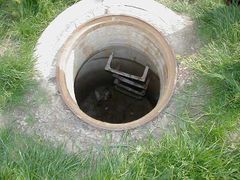Manhole
This article is about Manholes. For other uses, see Manhole (disambiguation).
| Manholes | |
|---|---|
The gaping maw of a circus. | |
| Scientific classification | |
| Kingdom | Plantae |
| Phylum | Shadophyta |
| Class | Shadolopsida |
| Order | Alcolopsia |
| Family | Manholaceae |
| Specifications | |
| Intelligence | High |
| Weight | A lot |
| Length | Unknown |
Manholes are large, subterranean shrubberies of the family manholaceae. They are colloquially known as manholes for their maws, the one part typically visible above ground, as they become gaping holes into which a man could easily fall when opened. As of 2010, 8 species of manhole have been definitely classified on Earth, although only three are common to every continent. Typically found in urban areas, they lie dormant underfoot as countless humans walk across them, oblivious.
A manhole consists of an underground chamber and a smaller surface opening called the 'maw'. Many species share a network of interconnected subterranean tubes with other manholes; it it theorised that this is both how they communicate and reproduce.
Shhh! I think heard something!
...
It... it must have been nothing. Nevermind.
Classification[edit | edit source]
A manhole is a large, hollow budding plant. The family Manholaceae consists of two genera:

Genus Utilitus[edit | edit source]
The manholes of the genus Utilitus, often called utility holes, tend to be large and blocky, and are distinguished by their visible internal organs. Many species even use these as a lure to capture prey if the cables can be convincing enough to make workmen think that the thing is indeed not a plant and really is a mythical 'real' utility hole.
What was that?
- Utilitus Circus: These manholes are possibly the most common. Circular-mawed and brimming with cable-like organs (cabeca), circus hails from six of the seven earthan continents.
- Utilitus Cubus: Similar to circus, cubus manholes differ only in their maws, sometimes raised but invariably of rectangular disposition.
- Utilitus Compartus: Originally considered a subspecies of Cubus, these manholes consist of what appear to be multiple connected
I... I hear them. They're coming. Oh, god...
They're... they're coming!
compartments. The fact that their compartments contain the entirety of the underground structure as well as the surface maw resulted in their designation as a separate species in 1995.
- Utilitus Cementus: Perhaps the most well-adapted of the Manholaceae to urban environment, Cementus manholes appear to be nothing more than cement until they open their maws. Their chameleon-like adaption has enabled Cementus to become one of the most rapidly expanding plants on the planet.
- Utilitus Cablacea: Similar to Utilitus, Cablacea contain often very realistic cable-like organs or cabeca within their internal structure. However, dissection of these manholes has revealed that they contain almost nothing but cabeca and little to no free space. As such, it is unknown exactly how these manholes feed, or if, indeed, they do at all.
You! You hear them too!
You have to save me!
You! Help!
...
<insert name here>?
Genus Aquitus[edit | edit source]
- Aquitus Sevant: Only appearing in areas with developed sewage systems, Sevant manholes tap into these systems and filter the sewage, making them potentially the most useful species of manhole to humans. However, due to their highly territorial and difficult nature, cultivating them has met little success.
- Aquitus Apescus: Apescus manholes are thus far the only species of plant on earth to grow their own food supply in an internal structure. These manholes contain a tank of still water, unlike other Aquitus, and in it they most prominantly cultivate fish, as well as sometime crabs, crocodiles, mutants, and fungi.
Can you even hear me?
Oh god, oh god...
- Aquitus Abundus: Probably the most contested group of manholes, Abundus is not so much a species as simply all of the sorts of manholes that could not be classified under anything else, called Abundus merely because there are a lot of them. Many taxonomists consider this to be "incredibly stupid", but until someone actually does come up with individual classifications, it appears that this is how the classification shall remain.
Can't you hear me? The manholes are coming! The manholes are coming!
History[edit | edit source]
The first recorded incidences of manholes in a municipality occurred in 1793 in Leningrad on the Niva River.
How can you not hear that? You can't even hear me, can you... you can't...
Previously only taking to rural areas, Manholiceae underwent an explosive radiation after their initial foothold, rapidly spreading and adapting to urban centers the world over to become the species seen today.
It is theorised that the first spread occured
Just shut up! Shut up!
You don't know them like I do. They're coming.
They're coming...
when
SHUT UP! STOP! ENOUGH!
They're coming for me. For you, too. They know you now.
They're coming they're coming they're coming THEY'RE COMING AND THEY'RE COMING FOR ME and they're coming! They're coming! Oh god, oh god.... they're coming, they're coming. They're coming they're coming they're coming they're coming they're coming they're coming they're coming they're coming.
They're... coming.
They're coming. They're coming for me. They're coming for all of us! THEY'RE COMING!
Oh god, I don't want to die. Not like this.
Not like...
They're coming.
